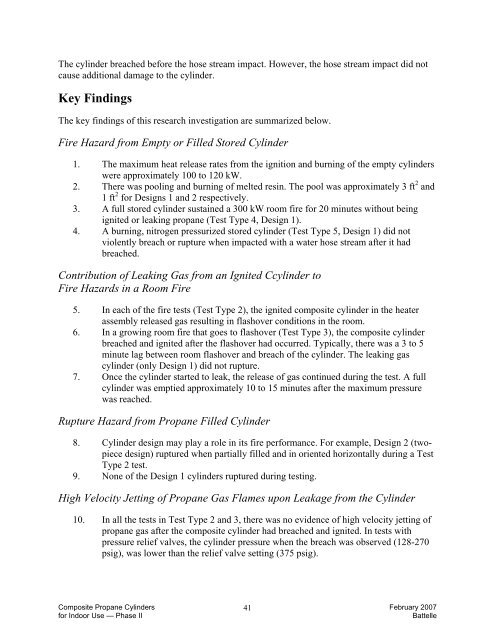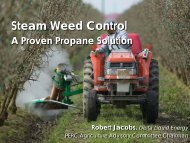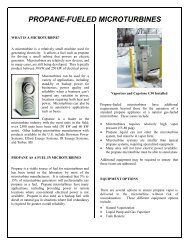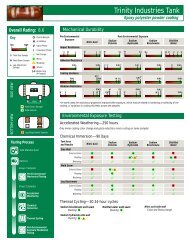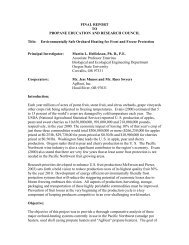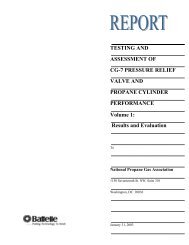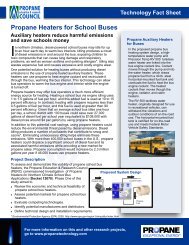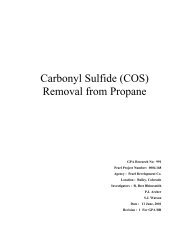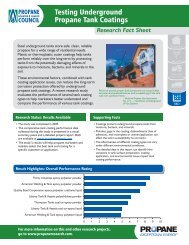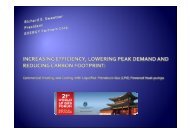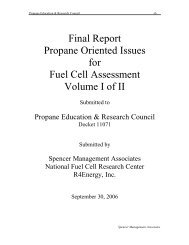Code Approval of Composite Propane Cylinders for Indoor Use ...
Code Approval of Composite Propane Cylinders for Indoor Use ...
Code Approval of Composite Propane Cylinders for Indoor Use ...
Create successful ePaper yourself
Turn your PDF publications into a flip-book with our unique Google optimized e-Paper software.
The cylinder breached be<strong>for</strong>e the hose stream impact. However, the hose stream impact did notcause additional damage to the cylinder.Key FindingsThe key findings <strong>of</strong> this research investigation are summarized below.Fire Hazard from Empty or Filled Stored Cylinder1. The maximum heat release rates from the ignition and burning <strong>of</strong> the empty cylinderswere approximately 100 to 120 kW.2. There was pooling and burning <strong>of</strong> melted resin. The pool was approximately 3 ft 2 and1 ft 2 <strong>for</strong> Designs 1 and 2 respectively.3. A full stored cylinder sustained a 300 kW room fire <strong>for</strong> 20 minutes without beingignited or leaking propane (Test Type 4, Design 1).4. A burning, nitrogen pressurized stored cylinder (Test Type 5, Design 1) did notviolently breach or rupture when impacted with a water hose stream after it hadbreached.Contribution <strong>of</strong> Leaking Gas from an Ignited Ccylinder toFire Hazards in a Room Fire5. In each <strong>of</strong> the fire tests (Test Type 2), the ignited composite cylinder in the heaterassembly released gas resulting in flashover conditions in the room.6. In a growing room fire that goes to flashover (Test Type 3), the composite cylinderbreached and ignited after the flashover had occurred. Typically, there was a 3 to 5minute lag between room flashover and breach <strong>of</strong> the cylinder. The leaking gascylinder (only Design 1) did not rupture.7. Once the cylinder started to leak, the release <strong>of</strong> gas continued during the test. A fullcylinder was emptied approximately 10 to 15 minutes after the maximum pressurewas reached.Rupture Hazard from <strong>Propane</strong> Filled Cylinder8. Cylinder design may play a role in its fire per<strong>for</strong>mance. For example, Design 2 (twopiecedesign) ruptured when partially filled and in oriented horizontally during a TestType 2 test.9. None <strong>of</strong> the Design 1 cylinders ruptured during testing.High Velocity Jetting <strong>of</strong> <strong>Propane</strong> Gas Flames upon Leakage from the Cylinder10. In all the tests in Test Type 2 and 3, there was no evidence <strong>of</strong> high velocity jetting <strong>of</strong>propane gas after the composite cylinder had breached and ignited. In tests withpressure relief valves, the cylinder pressure when the breach was observed (128-270psig), was lower than the relief valve setting (375 psig).<strong>Composite</strong> <strong>Propane</strong> <strong>Cylinders</strong> 41February 2007<strong>for</strong> <strong>Indoor</strong> <strong>Use</strong> — Phase IIBattelle


